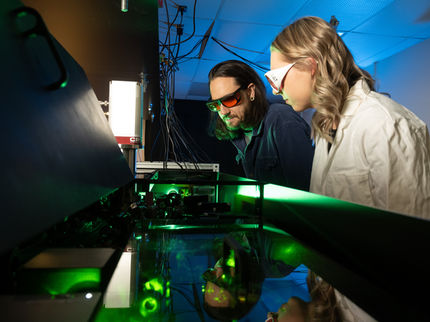UNH chemists create molecule with promising semiconductor properties
Advertisement
A team of chemists from the University of New Hampshire has synthesized the first-ever stable derivative of nonacene, creating a compound that holds significant promise in the manufacture of flexible organic electronics such as large displays, solar cells and radio frequency identification tags. The team, led by professor of organic chemistry and materials science Glen Miller and including two UNH undergraduates, published their findings in January 2010 in the Journal of the American Chemical Society.
Nonacene, a compound with nine rings of benzene fused in a linear fashion, belongs to a class of organic semiconductors called acenes, widely recognized to be among the very best in terms of electronic performance. Yet they are highly unstable – they oxidize rapidly.
"We have known that nonacene would have very desirable electronic properties, but it was just a tease, because you couldn't make it, you couldn't use it," says Miller, who has been working to prepare large acenes since 2007.
Miller and his team – research scientist Irvinder Kaur, postdoctoral fellow Mikael Jazdzyk, and UNH seniors Polina Prusevich and Nathan Stein – built the large nonacene derivative from smaller pieces, the way one might build a Lego structure. The key to the molecule's stability is the addition of arylthio functional groups, stable collections of atoms that contain sulfur.
"The skeleton of the molecule is still there, but it's got additional functional groups attached to the skeleton," says Miller. This not only made the derivative stable, it also made it soluble, further enhancing its usefulness.
Nonacenes hold promise for further development of flexible organic electronic devices: computer displays so thin they could be rolled up or even worn. Miller notes that the military is interested in the technology that would allow for chameleon-like camouflage clothing that could change with the environment. Organic solar cells are another potential application of nonacenes; such cells could cut the cost of solar power by making use of inexpensive organic molecules rather than the expensive crystalline silicon that is used in most solar cells.
While Miller notes that his team's work is but a first step toward creating stable nonacene devices, "these compounds push all of these technologies further."
"Before our work, the thought of preparing flexible organic electronic devices using nonacene or a nonacene derivative was just a dream," he adds. "With this major step forward, we are much closer to realizing the dream."
Original publication: Irvinder Kaur, Mikael Jazdzyk, Nathan N. Stein, Polina Prusevich and Glen P. Miller; "Design, Synthesis, and Characterization of a Persistent Nonacene Derivative"; J. Am. Chem. Soc., 2010, 132 (4), pp 1261-1263
Other news from the department science
Most read news
More news from our other portals
See the theme worlds for related content
Topic world Synthesis
Chemical synthesis is at the heart of modern chemistry and enables the targeted production of molecules with specific properties. By combining starting materials in defined reaction conditions, chemists can create a wide range of compounds, from simple molecules to complex active ingredients.

Topic world Synthesis
Chemical synthesis is at the heart of modern chemistry and enables the targeted production of molecules with specific properties. By combining starting materials in defined reaction conditions, chemists can create a wide range of compounds, from simple molecules to complex active ingredients.

























































